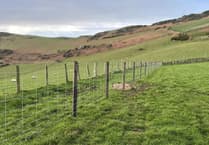With the clocks recently springing forward, it’s a good time to look at some of the many fabulous clocks in the Brecknock Museums collection at y Gaer and the fascinating stories behind them.
“A bracket clock, with an ornate brass face and decorated brass surround, is linked to a very well-known piece of local history,” said Collections Assistant Jacquie Morgan.
“It was purchased by Abraham and Esther Hamer with part of the £20 reward money they received for finding the body of missing 5-year-old Tommy Jones on 2nd September 1900.”
Tommy became lost when walking the short distance between the Login and his grandfather’s house at Cwm Llwch. Extensive searches were made for four weeks before Mr Hamer, an under-gardener at Castel Madoc near Lower Chapel, and his wife, discovered Tommy’s body high up in the Beacons, hundreds of feet above Cwm Llwch. The spot is now marked by an obelisk. The jurors at the inquest gave their fees to start a fund for this memorial, and Mr & Mrs Hamer contributed part of theirreward.
“We have a splendid longcase clock made by the Williams family of Trecastle in 1809,” explained Jacquie.
“The decorated dial is typical of clocks of this period, with the numerals of the clock face replaced by letters spelling out the name of William Watkins. The face is surrounded by floral designs, surmounted by a country scene.”

There were several generations of clock makers in the Williams family. Rees Williams (1737-1827) made clocks at his home at Ynisfaen, Cwmwysg, Trecastle. His son William was also a clockmaker at Cwmwysg, and another son Evan (born 1790) made clocks in Trecastle, next door to the Three Horse Shoes pub, where his workshop survived until 1968. Rees’s father Griffith and grandfather William were also clockmakers. One of Griffith’s clocks is in the Governor’s House in Gibraltar, another in the Fogg Art Museum in New York. William (1707-1786) made clocks, even the chain, wholly of wood.
20th century Ystradgynlais was home to two factories - known locally as Tick Tock - which were world-renowned for producing watches and clocks of exceptional quality. When Smiths Industries’ Anglo-Celtic Watch Company factory was opened in 1948 by Chancellor of the Exchequer Hugh Dalton, it was the largest watch manufacturing factory in Britain.
Dalton said, “We shall create up here among the Welsh mountains a new Switzerland, where for so long the watch and clock industry has grown and flourished.”
A sister business, Enfield Clock Company, moved to Ystradgynlais in 1949. The two factories employed hundreds of highly-skilled people, produced Ingersoll watches and 30 million clocks, and were central to community life through the Tick-Tock Social & Recreation Club and health and welfare schemes before foreign competition meant time ran out for clock making in Ystradgynlais in 1980.
Jacquie said: “The Enfield-made ‘Aberdeen’ which we have in y Gaer is an 8-day pendulum strike and chime clock. It has embossed figures on a cream face, held within a moulded walnut-finished case. We also have an Enfield-made ‘Nell Gwynne’ Cromwellian style brass clock, which is an 8-day, 15-jewel timepiece from the 1950s, plus two Ingersoll watches on display that were made in Ystradgynlais.”

A more recent timepiece in y Gaer is a Barbie watch bought in 1997 – so nearly two hundred years’ worth of timepieces are represented in the collection. If you have a moment, call in to pass some time in y Gaer and have a look at the clocks and watches, and find out more about them from the information on the tablet touch-screens next to the displays.
If you have any information about these timepieces, any stories about Tick Tock, or details about related topics to help us add to our knowledge, Jacquie would be delighted to hear from you.
Contact y Gaer on 01874 624121 or at [email protected] (FAO Jacquie Morgan).





